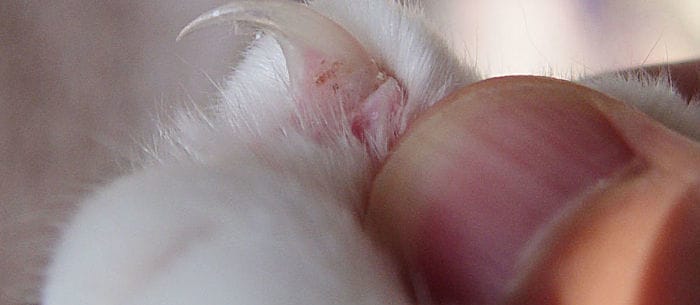Cat claws are one of the few holdovers from our domestic friends’ wild ancestors. These needle-sharp protrusions help cats catch prey, climb trees and defend themselves. Of course, your average pampered house cat uses his claws for little more than batting at cat toys. Still, the condition of the claws is important to cats’ overall well-being, and you need to make sure you’re helping your furry friend stay healthy.
A Complex Structure
Cat claws are similar to both our fingertips and fingernails, says Dr. Brenda Stevens, a clinical assistant professor in the department of clinical sciences at North Carolina State University College of Veterinary Medicine. Like our fingernails, claws have a keratin sheath that needs to be frequently shed, and it covers a nerve commonly called the quick.
That keratin sheath is the sharp, curved protrusion we see when cats extend their claws. However, cats’ claws are directly connected to a bone, so in that way they’re more similar to our fingertips. Cats also have ligaments that allow them to extend and retract their claws.
Keeping Claws Healthy
Cats are pretty good at maintaining their own cat claw health, but problems can crop up. “The biggest problem is usually overgrowth,” says Dr Stevens. “If the cat doesn’t have a substrate to sharpen them and shed them, they can get overgrown and grow into the pad.” The paw pad can then get infected, causing a lot of discomfort and possible complications for the cat.
Older cats, like older people, can develop thicker nails that are harder to shed and can overgrow as a result. And polydactyl cats — those with an extra toe — have an extra toenail on that “bonus” toe that lacks the ligaments that would allow it to extend, scratch and shed normally, so that extra claw needs to be trimmed to avoid overgrowth.
Scratching the (Right) Surface
The key to keeping cat claws healthy is to encourage their normal cat behavior in scratching and sharpening their claws, Dr. Stevens says. It’s important to keep their claws shedding their keratin sheath as needed, and scratching is how they do that. You want to discover which substrate, or surface, your cat prefers scratching so she’ll keep coming back to it (and, hopefully, stay away from your couch).
Store-bought substrates for scratching usually come in wood, carpeting, rope or corrugated cardboard, and all cats have different preferences — there is not one that is better than another for cat claw health. Stevens recommend buying a lot of different types and placing them around the house at as many different angles as possible. Some cats prefer a straight post, others like them to lie flat and others prefer an angle somewhere in between.
“You need to see if each post offers the substrate and verticalness (for lack of a better word) cats enjoy,” she says.
Clipping With Care
Trimming a cat’s claws helps keep him healthy. Any owner who has attempted this, however, knows it can be a difficult task for both you and your cat. Dr. Stevens recommends going slowly, only trying to snip one or two claws at a time and using lots of positive reinforcement and treats. With some cats, you may need to take them to the groomer or the vet to get this done, and some even need light sedation.
Dr. Stevens says the most important thing to remember is that cat scratching is normal cat behavior, not a bad habit you need to break them of. “It keeps their nails healthy, and it’s the best way to get the keratin sheath shed,” she says. Keep lots of scratchable surfaces around, and your cat will have healthy nails for years to come.
Wondering how to trim your kitty’s nails? Read A Guide to Clipping Cat Nails.
Freelance journalist Amy Kuras lives in Detroit with two cats, two children, one dog and one husband.




